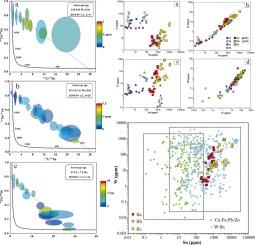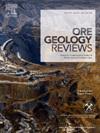Multiple generations of garnet and their genetic significance in the Niukutou cobalt-rich Pb-Zn-(Fe) skarn deposit, East Kunlun orogenic belt, western China
IF 3.2
2区 地球科学
Q1 GEOLOGY
引用次数: 0
Abstract
The Niukutou deposit, situated within the Qimantagh ore-concentrated area of the East Kunlun Orogenic Belt (EKOB), represents a typical skarn-type Pb-Zn-(Fe) deposit that is also associated with cobalt (Co) mineralization. The main ore minerals include galena, sphalerite, magnetite, hematite, Co-bearing arsenopyrite, cobaltite and glaucodot. This study conducted geochronological and chemical composition analyses of multi-generational garnets from the deposit, aiming to elucidate their genetic significance in the mineralization process. Field and mineralogical observations indicate the presence of three generations of garnets: Grt-I, Grt-II, and Grt-III. The earliest garnet generation (Grt-I) formed during the prograde stage, typically in garnet skarns, and is often replaced by epidote. The second generation (Grt-II), which coexists with pyroxene, also formed during the prograde stage, whereas the third generation (Grt-III) is associated with pyrrhotite stockworks, suggesting its formation during the sulfide stage. Using in-situ LA-ICP-MS U-Pb dating, garnets yield ages of approximately 230–234 Ma, which aligns with the age of 231.8 ± 7.5 Ma obtained from hydrothermal titanite in the deposit. These ages, combined with those of the previous studies, indicate major magmatic and metallogenic activity of 220–240 Ma in the Qimantagh area. Each generation of garnets displays oscillatory zoning characterized by alternating andradite and grossular compositions. The variations in Sn and high field-strength element (HFSE) contents across different garnet generations indicate an increasing trend in oxygen fugacity as mineralization progresses. The high Sn contents in the Niukutou garnets provide geochemical clues for the potential of Sn-W mineralization in this deposit, which should pay attention to in future exploration. Additionally, the high As concentrations in the Niukutou garnets suggest an As-rich hydrothermal fluid, which, owing to the stronger affinity of cobalt for sulfarsenides over sulfides, provides a geochemical indicator for the formation of abundant Co-bearing sulfarsenides rather than cobaltiferous sulfides in the deposit.

中国西部东昆仑造山带牛角头富钴铅锌(铁)矽卡岩矿床中的多代石榴石及其遗传意义
牛硐头矿床位于东昆仑造山带(EKOB)祁漫塔格矿石集中区,是典型的矽卡岩型铅锌(铁)矿床,也伴生钴(Co)矿化。主要矿石矿物包括方铅矿、闪锌矿、磁铁矿、赤铁矿、含钴砷黄铁矿、钴矿和萤石。这项研究对矿床中的多代石榴石进行了地质年代和化学成分分析,旨在阐明它们在成矿过程中的遗传意义。野外和矿物学观察表明存在三代石榴石:Grt-I、Grt-II 和 Grt-III。最早的一代石榴石(Grt-I)形成于原生阶段,通常位于石榴石矽卡岩中,经常被表长石所取代。第二代石榴石(Grt-II)与辉石共存,也是在原生阶段形成的,而第三代石榴石(Grt-III)则与黄铁矿堆积物有关,表明它是在硫化物阶段形成的。利用原位 LA-ICP-MS U-Pb 测定法,石榴石的年龄约为 230-234 Ma,这与该矿床热液榍石的年龄 231.8 ± 7.5 Ma 相吻合。这些年龄与之前研究的年龄相结合,表明奇曼塔格地区在 220-240 Ma 期间有大规模的岩浆和金属生成活动。每一代石榴石都显示出振荡分带,其特征是安氏斜长石和毛玻璃成分交替出现。各代石榴石中锡和高场强元素(HFSE)含量的变化表明,随着成矿作用的进行,富氧性呈上升趋势。Niukutou石榴石中的高锡含量为该矿床潜在的锡-钨矿化提供了地球化学线索,在未来的勘探中应加以重视。此外,Niukutou石榴石中的高砷浓度表明富含砷的热液流体,由于钴对硫砷化物的亲和力强于硫化物,这为该矿床形成丰富的含钴硫砷化物而非含钴硫化物提供了地球化学指标。
本文章由计算机程序翻译,如有差异,请以英文原文为准。
求助全文
约1分钟内获得全文
求助全文
来源期刊

Ore Geology Reviews
地学-地质学
CiteScore
6.50
自引率
27.30%
发文量
546
审稿时长
22.9 weeks
期刊介绍:
Ore Geology Reviews aims to familiarize all earth scientists with recent advances in a number of interconnected disciplines related to the study of, and search for, ore deposits. The reviews range from brief to longer contributions, but the journal preferentially publishes manuscripts that fill the niche between the commonly shorter journal articles and the comprehensive book coverages, and thus has a special appeal to many authors and readers.
 求助内容:
求助内容: 应助结果提醒方式:
应助结果提醒方式:


